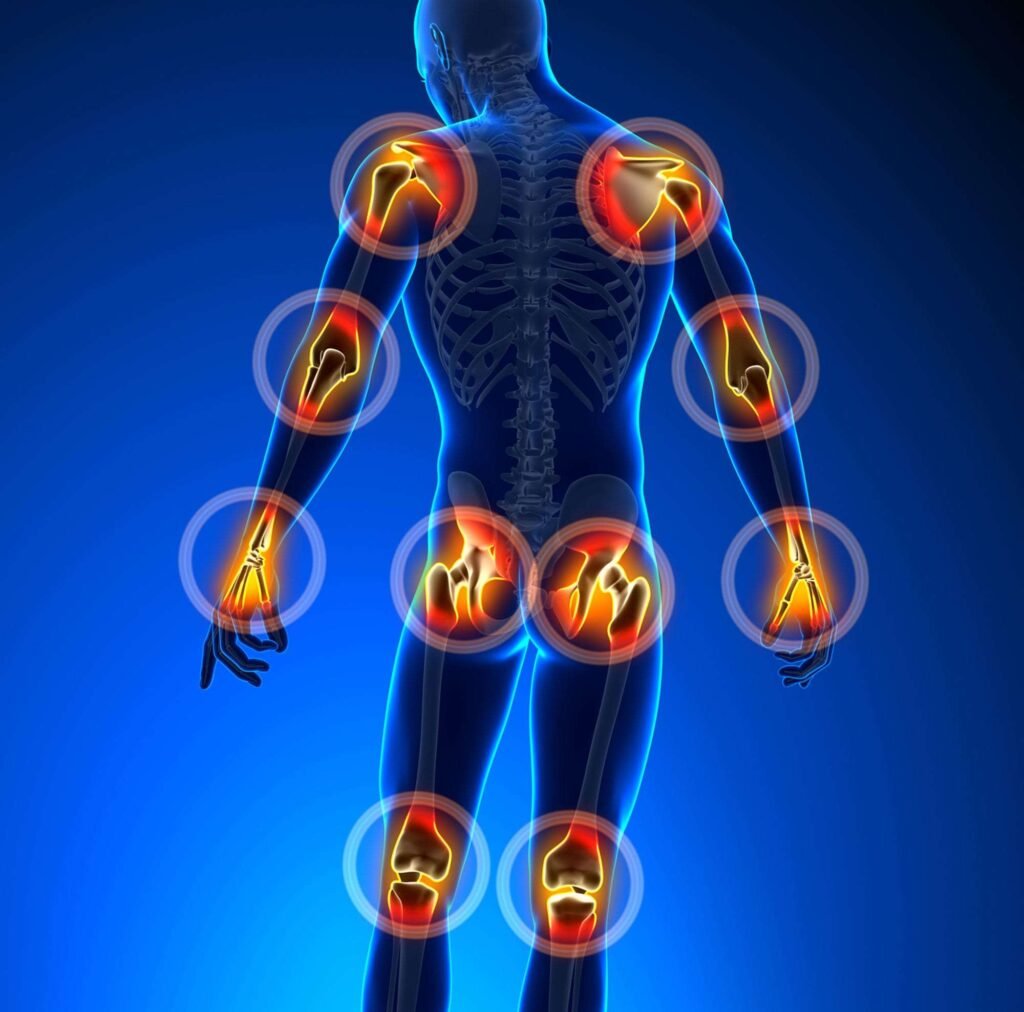Joint pain refers to discomfort, soreness, or inflammation in any of the joints of the body, which are the areas where two or more bones meet. This type of pain can be mild to severe and can affect a single joint or multiple joints. It can be temporary or chronic, depending on the cause. Joint pain is commonly associated with conditions like arthritis, injuries, or overuse, and it may be accompanied by swelling, redness, and stiffness.

- Arthritis:
- Osteoarthritis: The most common form of arthritis, which occurs due to wear and tear of the cartilage that cushions the joints. This leads to pain, stiffness, and swelling.
- Rheumatoid Arthritis: An autoimmune disease where the body’s immune system attacks the synovial lining of the joints, leading to inflammation, pain, and joint damage.
- Gout: A form of arthritis caused by the accumulation of uric acid crystals in the joints, often affecting the big toe, leading to sudden and severe pain, redness, and swelling.
- Injuries:
- Sprains, strains, or fractures can lead to joint pain. These injuries can occur from accidents, falls, or sports-related activities.
- Tendinitis: Inflammation of the tendons (the connective tissue that attaches muscle to bone), often due to overuse or repetitive motion.
- Bursitis: Inflammation of the bursa (small fluid-filled sacs that cushion the joints), typically caused by repetitive movements or prolonged pressure on the joint.
- Infections:
- Infections such as septic arthritis can cause joint pain, often accompanied by fever, warmth, and redness in the affected joint.
- Viral infections, like the flu, can sometimes cause joint pain as a secondary symptom.
- Autoimmune Diseases: Conditions like lupus or psoriatic arthritis occur when the immune system mistakenly attacks healthy joint tissues, leading to inflammation, swelling, and pain.
- Overuse or Repetitive Stress: Activities that involve repetitive motions (e.g., running, typing, or lifting) can strain the joints, leading to pain and stiffness.
- Fibromyalgia: A chronic condition that causes widespread muscle and joint pain, fatigue, and sleep disturbances. The exact cause is unknown, but it is believed to be linked to abnormal pain processing by the brain.
- Joint Inflammation (Synovitis): Inflammation of the synovial lining of a joint can lead to pain, stiffness, and swelling.
- Hormonal Changes: Conditions such as menopause or pregnancy can affect the joints due to hormonal changes, leading to joint discomfort.
Symptoms of Joint Pain:
- Pain: May be sharp, dull, aching, or throbbing, and can vary in intensity.
- Stiffness: Difficulty moving the joint or feeling tightness, especially after resting.
- Swelling: The joint may appear enlarged due to fluid accumulation or inflammation.
- Redness and Warmth: Inflammation can cause the skin around the joint to become red and warm to the touch.
- Limited Range of Motion: Difficulty moving the joint fully due to pain or stiffness.
- Tenderness: The joint may feel sore when touched.
Treatment for Joint Pain:
- Rest: Allowing the joint to rest and avoid activities that worsen the pain can help reduce inflammation and speed up recovery.
- Ice and Heat Therapy: Applying an ice pack to reduce swelling or a heat pad to relax muscles can provide relief.
- Over-the-Counter Medications:
- Pain relievers: Nonsteroidal anti-inflammatory drugs (NSAIDs) like ibuprofen or naproxen can help reduce pain and inflammation.
- Acetaminophen: For pain relief, especially if inflammation is not present.
- Physical Therapy: Targeted exercises and stretches can help strengthen the muscles around the joint, improve flexibility, and reduce pain.
- Compression: Wrapping the affected joint with an elastic bandage or using a brace can provide support and reduce swelling.
- Elevate the Joint: Keeping the joint elevated can reduce swelling, especially if there’s an injury or inflammation.
- Steroid Injections: For chronic or severe inflammation, doctors may administer corticosteroid injections directly into the joint to reduce inflammation and relieve pain.
- Joint Protection: Using assistive devices (like splints or braces) or modifying activities to avoid excessive strain on the joint.
- Surgery: In cases of severe joint damage or arthritis, surgery, such as joint replacement or arthroscopy, may be recommended.
Prevention of Joint Pain:
- Maintain a Healthy Weight: Excess weight puts additional stress on weight-bearing joints, especially the knees, hips, and spine.
- Exercise Regularly: Engage in low-impact exercises such as swimming, walking, or cycling to strengthen muscles and improve joint flexibility.
- Use Proper Technique: When lifting heavy objects or participating in sports, use the correct posture and techniques to avoid strain on your joints.
- Stretch and Warm-Up: Before engaging in physical activities, ensure you properly stretch and warm up to avoid injuries.
- Protect Joints During Activities: Use supportive footwear, avoid overuse, and take breaks during repetitive tasks to reduce the risk of joint stress.
When to See a Doctor:
- If joint pain is persistent, severe, or accompanied by symptoms like fever, unexplained weight loss, or significant swelling, it’s important to seek medical attention.
- If the joint pain is interfering with daily activities or is accompanied by redness, warmth, or signs of infection, consult a healthcare provider.
